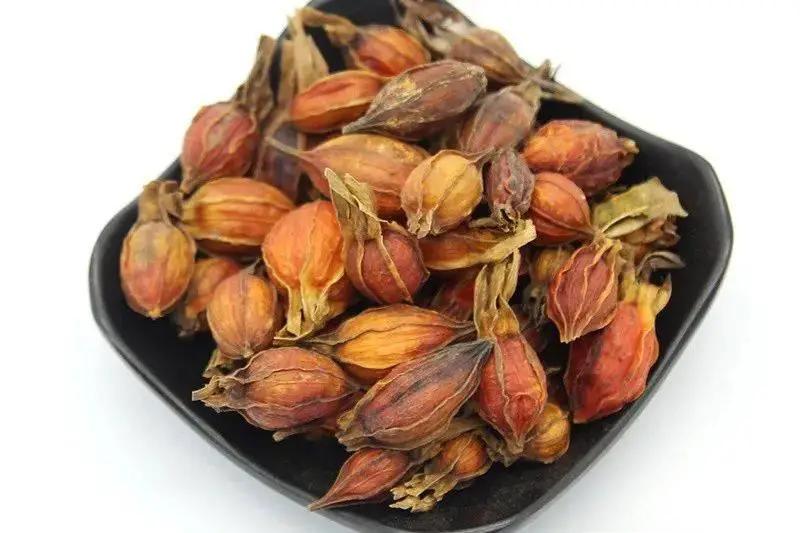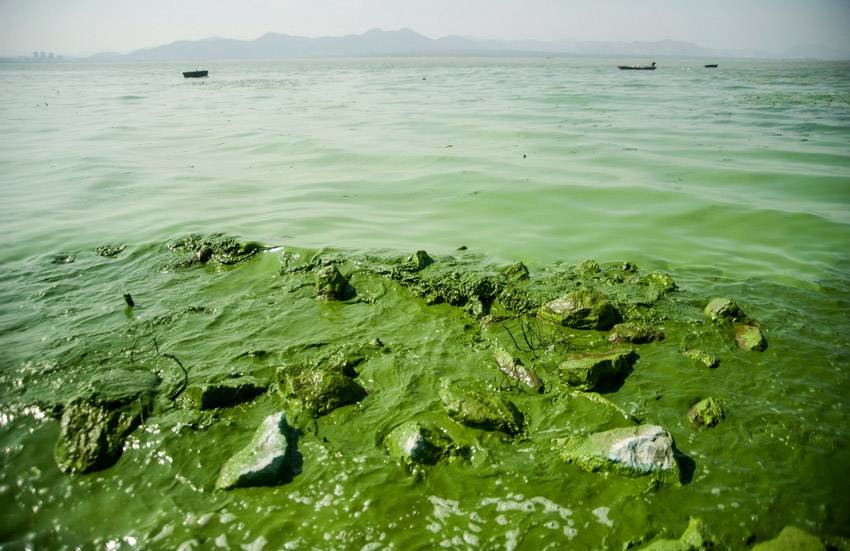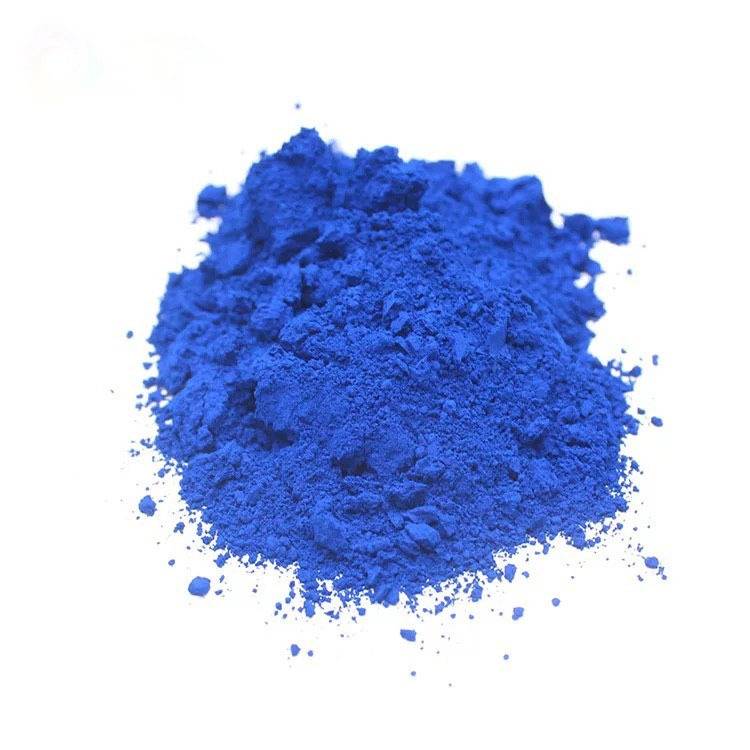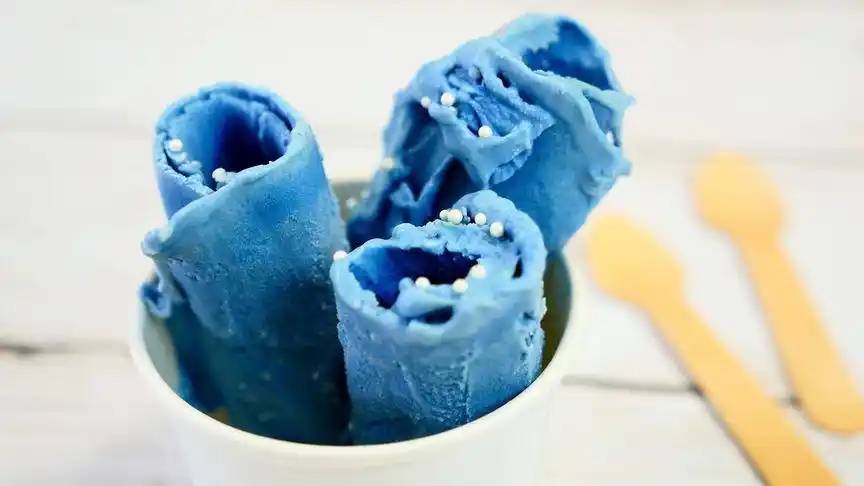중국의 천연청색 식용색소에 관한 연구
Pigments are substances that can color the object being dyed. They are also known as colorants and have a wide range of applications in production, life, and scientific research. The history of pigment development and application around the world is also very long. Since the British W. H. Perkins synthesized the organic pigment aniline violet for the first time in the world in 1856, synthetic pigments have dominated the pigment market due to their excellent performance, low price, and ease of use. However, since countries or institutions such as the United Kingdom (1967), the United States (1973), and the World Health Organization (1984) have successively questioned the safety of synthetic pigments (tar pigments) on the human body, and there have been more and more reports on the research of the hazards of pollutants such as arsenic and lead that may be brought in during the synthesis process, the variety of products using these pigments in various countries is gradually decreasing. The number of synthetic food colors permitted for use in China has also been reduced from more than 30 in the past to 10 at present, and the rapid development of natural pigments will be an inevitable trend [2].
천연 색소 generally refer to pigments made by using substances that exist in nature (such as plant and animal materials) or secondary metabolites produced by cultivation methods and undergoing certain processing. Due to their advantages of being safe and reliable, non-toxic and having no side effects, natural hues and versatility, they have been widely used with the development of the food industry, pharmaceutical industry, daily chemical industry and aquaculture industry. Currently, 43 types of natural pigments are permitted for use in food in China. Natural pigments have already dominated the food coloring market and are growing at a rate of 10% per year [3]. The raw materials for processing natural pigments come from a wide range of sources (from animals and plants, microorganisms, minerals, etc.), and there are many types (as of 2004, there were about 600 recorded types [4]).
그러나 이런 재료로 만든 천연안료는 주로 적색톤과 황색톤이며 청색안료는 매우 드물다.'귀하다','극소수','희귀하다'[5-7] 등의 단어로 문헌에 자주 언급된다.차이나&에 수록된 56가지 안료 중#39;s GB2760-2007"식품첨가물사용위생기준", 청색색소는 정원청색색소와 phycocyanin (즉 해조류청색알백색색소) 두가지뿐이다.파란색은 3원색 중 하나로 다양한 색조를 섞는 데 사용할 수 있다.그러나 천연청색안료는 그 희소성으로 하여 국내시장과 국제시장에서 모두 공급이 딸리고있다.따라서 천연 청색 안료의 적극적인 연구 개발은 실용적으로 매우 중요하며 [8] 매력적인 시장 전망을 가지고 있다.
천연 블루 안료의 천연 원료 1
천연 청색 안료 are rare among natural pigments, and their natural sources are also very limited. Organic natural 파란색 안료 are mainly derived from plants and microbial materials. The leaves of plants in the genus Indigofera, such as indigo, tea blue, horse blue, Wu blue and woad, can be used to make indigo dye [4]. Gardenia blue is made from gardenia glycoside in the fruits of Gardenia jasminoides [8]. Plant sources such as Ophiopogon japonicus fruit [9–10], Peristrophe baphica [11], Brassica oleracea [12], and purple and blue-grained wheat seeds [13] are used to produce the corresponding blue pigments. Although it has been reported that genetically modified cotton and genetically modified roses can produce blue pigments, these genetically modified plant materials cannot be used to produce natural blue pigments at present due to their rare sources [14–15]. Algae such as spirulina, cyanobacteria and chlamydomonas can be used to produce algin blue pigments [16-18]. The oyster shell algae Haslea ostrearia can produce the blue malachite pigment, which increases the economic value of oysters [19]. Garlic (Allium sativum) can turn green after being pickled in vinegar, and blue pigment can be isolated [20-21]. Some microorganisms such as Streptomyces sp., Pseudo- monas sp., Pseudoalteromonas sp., Duganella sp., Aureobasidium sp., purple non-sulfur bacteria, etc., can produce different kinds of blue pigments during growth using a culture medium. Some genetically engineered strains can produce indigo blue pigments [22-23].

천연 블루 안료의 구조 및 색상 2
Although natural blue pigments are similar in hue, their color-producing mechanisms are different. Ultimately, the different color-producing mechanisms are determined by differences in the chemical structure or spatial structure of the pigment molecules. The molecular structures of natural blue pigments prepared from different raw materials or by different methods may be different, and the physical and chemical properties and application scope of the pigments may also differ accordingly. The structures and related properties of common natural blue pigments are shown in Table 1.
루빅산틴이 청색으로 변하는 pH 범위는 매우 좁기 때문에 기술적으로 천연 청색 색소로 간주할 수 없습니다.
3 미생물 천연 청색 안료
대부분의 천연 청색 안료는 여전히 현재 동물 및 식물 재료로 생산되고 있지만, 계절, 기후, 원산지 등의 요인에 의해 이용 가능한 재료가 제한되어 있어 천연 청색 안료는 공급이 매우 제한적이며 따라서 가격이 비싸고 사용하기 어렵다.미생물은 신속히 생장하며 자연에는 색소를 산생할수 있는 종류가 풍부하다.미생물의 자원을 이용하여 천연색소를 생산하는 것은 기본적으로 자원, 환경, 시간, 공간의 제한을 받지 않기 때문에 식물이나 동물 기원의 재료를 이용하여 천연색소를 생산하는 것과 비교할 수 없는 장점이 있다.미생물을 이용해 천연색소를 만드는 것이 결국 천연색소의 주류원이 될 것이다 [24].
The use of microbial fermentation methods to produce a variety of natural pigments such as blue pigments and red yeast pigments has also become a reality [25]. In fact, the production of the main natural blue pigments on the market currently requires the participation of microorganisms. For example, the preparation of indigo blue pigments and gardenia blue pigments requires the participation of microorganisms in the fermentation process, while the cyanobacteria, spirulina, and chlorella that produce phycocyanin pigments are themselves microorganisms. In addition, there are still many microorganisms in nature that can produce natural blue pigments, but most of the work on using microbial fermentation to produce natural blue pigments is still at the laboratory stage [7]. There is still a long way to go before the industrial production of natural blue pigments using these microorganisms directly fermented culture medium can be realized. The reported blue pigment-producing microorganisms and their pigment-related properties are shown in Table 2.

미생물을 이용하여 청색안료를 생산하는 연구는 주로 몇 가지 측면을 포함한다:1.청색색소 생성 미생물의 선별 및 동정;2. 온도, 빛, pH, 금속 이온, 산소, 복잡한 화합물, 첨가제가 안료의 안정성에 미치는 영향 등 청색 안료의 물리 화학적 특성 및 일부 독성학적 특성 결정;청색안료의 분광학적 특성, 항산화 및 환원력, 항균활성, (암) 세포독성, 그리고 활성산소를 제거하는 능력;3. 발효청색소 배양액의 선별 및 최적화 (Screening and optimization of fermentation blue pigment culture media)일부 청색색소의 분자구조와 청색색소를 생산하는 미생물의 생리, 생화학, 분자수준에서 대사기전은 아직 불분명하다.산업생산을보다 잘 유도하기 위해서는 미생물발효청색색소의 산업적 발전을 위한 이론적 기초를 제공하기 위하여 많은 심도 있는 연구가 필요하다.
천연 블루 안료의 추출, 분리 및 후처리 4
정원류 청색소와 해조류 청색소는 천연 식품 색소로 시장에서 지배적인 두 가지 청색소입니다.Cyanobacteria와 red algae는 녹조 청색 안료의 두 가지 주요 원천이며, spirulina는 녹조 청색 안료 생산에 선호되고 가장 비용 효율적인 원료입니다.조류에서 녹조 청색 색소를 배출하기 위해 사용되는 처리 방법은 대부분 부식 억제제를 첨가하고, (초) 저온 동결 및 해동 후 균질화 [17, 40] 하거나, 효소 분해와 고압 균질화를 병행하여 조류 세포를 분해하는 방법 [39]을 사용한다.Nostoc과 같은 대형 조류의 경우 고속 조직 균질기를 이용하여 균질화를 수행한 후 효소적 용해 (미생물 발효와 조류의 자가분해를 통해 달성) [18]를 거친다.세포 균질액 내의 phycobiliproteins은 실리카겔 컬럼 크로마토그래피 [17]를 이용하거나 초임계 CO2 액을 이용하여 황색색소를 먼저 추출한 후 수용액 추출제를 이용하여 phycobiliproteins을 분리, 정제할 수 있다 [41].
The purified phycocyanin is vacuum-concentrated, and then freeze-dried or spray-dried to obtain a dry pigment powder. Microencapsulation before drying can improve the heat resistance of the pigment [18]. There are currently two processes for preparing gardenia blue pigment from gardenia fruit powder: one is a one-step process in which gardenia blue pigment is produced by fermenting gardenia fruit powder aqueous extract with an enzyme-producing strain; the other is a two-step process in which gardenoside is first separated and concentrated from gardenia fruit powder aqueous extract, and then gardenia blue pigment is produced by enzymatic reaction.
첫 번째 공정으로 색감이 칙칙하고 색값이 낮은 가드니아 블루를 제작한다.이후 단계에서 분리 · 정화가 어렵고 수율도 낮다.제2 공정은 이러한 문제를 더 잘 해결한다 [42~43].Gardenin은 macroporous 흡착수지 (HPD100 등) 컬럼을 이용하여 gardenia 열매분말물 투입액에서 황색색소를 추출한 후 남은 폐액에서 발견된다.이후 폐액을 농축하고 농축하는 기술을 이용하여 막여과 (미세여과 (0.1 μ m) 해명과 nanofiltration (100달 튼) 농도) [44], [45], dual-phase 추출 및 고속 countercurrent 크로마토그래피 (HSCCC) [46] 고품질 파란 색소니아을 준비하였다.준비된 색소는 초미세 여과 [47], 키토산 유도체 컬럼 크로마토그래피 [44] 또는 (D301) 대성 흡착수지 컬럼 크로마토그래피 [48] 등의 기술로 정제 및 정제된다.

천연안료의 안정성이 떨어지고 쉽게 분해되는 일반적인 단점으로 인하여 천연안료의 안정성 향상을 위한 연구가 증가하고 있다.수용성 가드니아 청색 안료를 아세트산 무수물로 에스테르화하여 소수성 가드니아 청색 안료를 얻었으며, 이를 통해 적용 범위를 확대하고 안정도 또한 어느 정도 향상시켰다 (49-50);자색배추 청색색소는 페룰산 (ferulic acid)과 살리실산 (salicylic acid)으로 아실화된 후 열 및 광에 대한 저항성이 상당히 개선되었으나 [51], 일반적으로 천연 청색색소의 개량에 대한 연구는 아직 거의 없다.
5 전망
차이나&에서 사용이 허용된 43가지 천연 안료 중#39;s current GB2760-2007 edition of Hygienic Standards for Uses of Food Additives, there are only two kinds of blue pigments: gardenia blue pigment and spirulina 블루 색소다.China's의 정원사와 말린 스피룰리나의 생산량은 세계 1위 [1만 6 천 42] 이지만 중국 정원사 청색색소의 품질은 1980년대 수준으로 아직 일본에 비해 20년 뒤져 있다.가드니아 레드는 일본에서 25년째 시판되고 있지만 중국은 아직 공백이다 [8].현재 중국에서 생산되는 정원용 청색안료의 98% 가 수출되고 있지만, 중국 내 천연용 청색안료의 전반적인 생산량은 높지 않으며, 이러한 안료의 중국 내 공급은 아직 부족한 실정이다 [46].

매년 10%의 속도로 성장하고 있는 거대한 천연색소 시장에 직면한 중국의 천연색소 개발은 색소 품종의 부족, 공급원의 상대적 부족, 고비용 [52] 등의 문제에 직면해 있다.이러한 점을 감안하여 향후 중점은 다음과 같은 분야에 두어야 한다:1.생산공정과 기술표준을 개선하고 청색안료의 생산과 질을 높이며 저가제품의 고급제품으로의 전환을 촉진하며 제품의 부가가치를 높인다.2. 기존 원료를 활용해 가드니아 레드 등 새로운 천연안료를 개발한다.셋째, 청색색소에 대한 천연 미생물 자원의 연구 및 이용에 큰 중요성을 두고 있으며, 청색색소의 새로운 균주를 개발하여 천연 청색소에 대한 국제적인 연구에서 주도권을 장악한다.이것은 동식물 기원의 재료로 생산한 천연청색안료가 시장수요를 충족시킬수 없는 상황을 개변시키는데 대하여 중대하고도 장원한 의의를 가진다.
참조
등지광, 량용, 류전화 등 [1].reversed-phase HPLC에 의한"blue pigment"의 신속한 결정.염색과 인쇄, 36 (17):35-39.
[2] Zou Zhifei, Pu Min, Li Jianjun 외.여러 나라 (지역)의 식용색소 사용현황 및 비교분석.중국식품위생학회지 2010, 22 (2):112-121.
[3]리 YW.청색색소를 생성하는 스트렙토마이세스 (Streptomyces)의 규명 및 색소의 발효조건 및 특성에 관한 연구 (originals:study of fermentation conditions and properties of the pigment-producing Streptomyces)Master's 논문, 안휘농업대학교, 2006.
[4] Xiang B, Gao JR. 천연 안료 [M].북경:화학공업출판사, 2004.
[5] 자오 H, 얀 HX.청색색소를 생산하는 해양 스트렙토마이세스 균주 및 그 색소 특성에 관한 연구 (J.식품연구개발, 2009, 30 (6):186-189.
[6] 진윤안.가치 있는 천연 식품 색소-보랏빛 색소와 청색 색소의 추출 기술 [J].귀주화학공업, 1995 (1):45-46.
[7] Li Y, Zhang M. Streptomyces zingiberensis 가 생성하는 청색색소의 특성에 관한 연구.
[8] 류 X 자오 B, 장 J 외.종합개발 및 활용 (Comprehensive development and utilization of gardenia)중국야생식물자원, 2008, 27 (1):19-26.
[9] 당천이, 당연화, 우옌 외.Ophiopogon japonicus 열매로부터 청색색소의 Microwave 추출 및 특성 (characteristics of the blue pigment from Ophiopogon japonicus fruit [J.중국산림부산물, 2005 (2):17-19.
[10] 청차오, 리웨이, 모카이주 등.자포 (Ophiopogon japonicus [J]) 열매의 청색색소의 안정성에 관한 연구 (the stability of the blue pigment in the fruit of Ophiopogon japonicus)식품과학, 2008, 29 (12):168-171.
시윤창, 원영신, 장샤오화 등 [11].남색 전구체의 분자 조성과 화학적 변화.광시식물학, 2003, 23 (4):367-369.
장리안펑, 자오리펑 中 스타 화보 공개 (12)보라색 양배추로부터 천연색소의 추출 및 특성.남양사범대학교 논문집 2005, 4 (3):51-52.
[13] 위안밍루.보라색 밀 [J]의 연구 진행.간쑤농업과학기술, 2008, 1:32-37.
[14] 장수섬유 편집부, 남색과 적색 면섬유는 유전공학적 방법으로 만든 것이다 (J.장수섬유 (A Edition), 2003 (6):31.
[15] 매기 유.푸른장미의 재조합 육종 [J.중국과학기술운수, 2006 (9):60.
[16] 펑야페이, 원옌메이, 리샹웬.해조류 블루-영양 및 건강 증진 기능이 풍부한 천연 색소입니다 [J].식품과학과 기술, 2007 (6):171-173.
[17] 가오톈룽, 쑨시중, 웨이샤오쿠이.스피룰리나 [J]에서 조류 파란색 색소 추출.연난사범대학 논문집 2002, 22 (1):28-29.
[18] 자오리앙중, 두안린동.Nostoc flagelliforme에서 파란색 안료의 추출 및 특성.식품산업과학과 기술, 1998 (2):24-26.
[19] 마오더장, 주일링, 싱신후이.청색안료 marennine [J]의 최근 연구 현황.식품과학, 2011, 32(5):321-325.
[20] 자오샤오단.식초에 절인 풋마늘의 기능과 녹색색소 [D]의 분리 및 특성.중국농업대학 박사학위 논문, 2005.
[21] 천콩. 마늘로부터 녹색색소 분리 및 정제 및 구조 확인 [D.Master's 논문, 산동농업대학교, 산동농업대학교, 2008.
[22] 이휘, 우연.카로티노이드와 인디고를 생산하는 균주에 대한 연구 [J].식품발효산업, 1997, 24 (2):7-10.
[23] 송징, 손영루, 장림명 외.남색 색소 효소 유전자의 발현과 대장균에서의 발현을 위한 벡터의 구축 (Construction of a vector for the expression of indigo pigment enzyme gene and its expression in Escherichia coli [J])하이테크커뮤니케이션, 2003 (9):39-42.
[24] 왕전, 장백산.천연색소의 미생물 생산 연구 진행 (J.Bulletin of Microbiology, 2007, 34 (3):580-583.
[25] 덩샹위안, 왕슈전, 리푸차오.천연안료의 자원 및 응용.중국 조미료, 2006 (10):49-53.
[26] 장 H C, 천 L,지 W M 외.청색색소를 생산하는 방선균 (actinomycete)의 예비 식별 및 색소의 특성에 대한 연구 (Preliminary identification of an actinomycete producing a blue pigment and study of properties of the pigment)우시경공업대학 논문집 1999, 18 (3):23-28.
[27] Zhao D H, Lu L, Qin H L. 미생물 발효에 의해 생성된 청색색소의 안정성 및 독성 (Stability and toxicity of blue pigment by microbial fermentation)식품발효산업, 1998, 24 (5):21-24.
[28] 등상원, 왕수전, 호우쥬메이 등.해양 Streptomyces M259에 의한 고수폐 청색안료의 물리, 화학적 특성에 관한 연구 (J.식품과학, 2006, 27 (7):35-39.
[29] 쑨옌타오, 루링.스트렙토마이세스 (Streptomyces) 가 생산하는 청색색소의 성분 분리 및 분석 (J.한국미생물학회지, 2007, 27 (6):5-7.
[30] 리이웨이, 천샤오린, 장밍.청색색소 생산균주의 생물학적 특성 및 염기성 (biological characteristics of a blue pigment-producing strain and the basic properties of the pigment)생물학회지 2007, 24 (1):41-43.
[31] 등민룡, 구준, 주홍희.Streptomyces violaceoruber 가 생산하는 대사산물과 관련 유전자들의 항균 및 항종양 활성에 관한 기초 연구.Natural Product Research and Development, 2010 (22):367-372.
[32] G F 고우스.Litmocidin은 proactinomyces cyaneus [J]에 의해 생성되는 새로운 항생물질.j. Bacteriol1946년, 51 (6):649-653.
[33] 공량위, 왕서린, 리옌빈.Pseudomonas aeruginosa 가 생산하는 phenazine 색소의 분리 및 정제와 적조생물의 성장에 미치는 영향 (J.푸단 저널 (자연과학편), 2004, 43 (4):494-506.
[34] 원루, 위안바오홍, 이호진.남중국해 해양세균인 Pseudomonas sp. 가 생산하는 청색색소로 항암활성을 갖는 [J.쑨원대학교 논문집 (자연과학편), 2005, 44 (4):63-65, 69.
[35] 쑨아이펑, 좡룽위, 왕궈량.해양세균 E18 균주의 청색-보라색 색소의 안정성 및 생물학적 특성에 관한 연구 (J.Bulletin of Microbiology, 2007, 34 (4):691-694.
[36] 왕해성, 루위안, 슈위안 외.Bacillus dujunii B2 [J]의 청색색소 성분의 분리 및 화학구조 분석.중국화학공학회지, 2008, 59 (3):630-635.
[37] 천보, 푸강준.Aspergillus niger (J)의 발효능에 관한 연구.식품기술, 2002 (11):15-17.
[38] Yue Huiying, Huang Xiao, Zhao Chungui 외.산소를 생성하지 않는 광합성 세균에서 광합성 색소의 조절 메커니즘 [J.Acta Microbiologica Sinica, 2009, 49 (3):331-336.
[39] 예하휘, 허시우펜, 왕쉬란.스피룰리나의 분쇄와 스피룰리나 푸른 색소의 추출 [J].한국열대농업학회지, 2001, 7 (3):24-30.
[40] 류화연, 왕설링.spirulina 블루 색소의 추출 및 안정성 연구 [J].허베이 경제경영대학 논문집 (종합판), 2001 (2):42-43.
[41] 장쿤, 팡옌, 샤오첸.spirulina [J] 로부터 천연식용색소의 추출에 관한 연구.장수식품과 발효, 1995 (3):19-22.
[42] 손리준.정원용 청색안료의 착색 메커니즘에 대한 논의와 2단계 과정에 대한 연구.안휘농업기술사범대학 논문집 1994, 8 (3):1-5.
[43] 장고려, 유순후, 이항복 외.연구논문:two-step 방법에 의한 정원청색색소 생산을 위한 공정조건에 관한 연구 (Study on the process conditions for gardenia blue pigment by a two-step method)식품과학, 2008, 29 (11):186-188.
[44] Ling Min, Jiao Yujian, Li Liming 외.색가가 높은 정원청색색소의 제조와 그 정제과정 연구 (Preparation of gardenia blue pigment with high color value)외식산업기술, 2009, 30 (6):262-264.
[45] 량화정, 리위안, 양수평.2 상 액-액 추출법으로 추출한 정원황폐액을 효소법에 의한 정원청색소 생성에 관한 연구 (J.식품학, 2009, 30 (3):155-158.
[46] Yang D, Zhou M, Zhu H 외.HSCCC에 의한 geniposide와 genipin의 분리와 이들의 색반응 [J.광시대학교 논문집 (자연과학편) 2010, 35 (3):493-496, 501.
[47] 양지, 장팡, 리메이 등.정원청색색소의 제조 및 정제과정에 관한 연구 (Study on the preparation and purification process of gardenia blue pigment)허난공업대학 논문집 (자연과학편), 2008, 29 (2):59-63.
[48] 리자춘, 량화정, 우지메이 등.macroporous resin에 의한 정원청색색소의 분리 및 정제에 관한 연구 (J.식품공학, 2005, (7):50-53.
[49] 양 Z, 장 F,린 X 외.hydrophobic gardenia blue pigment의 제조에 관한 연구 (J.허난대학 논문집 (자연과학 편), 2008, 29 (4):24-27.
[50] 장팽, 양지, 간천지.hydrophobic gardenia blue pigment의 안정성 연구 (J).허난대학 논문집 (자연과학 편), 2008, 29 (5):26-28.
[51] 천수홍, 허주평, 진위동 등.아실화 처리에 의한 천연색소의 안정화에 관한 연구 (the Study on the stabilization of natural pigments by acylation treatment)식품공학, 2008 (2):151-153.
[52] 슈앙휘, 두치젠, 하명.천연 청색 안료 [J] 연구 진행.식품연구개발, 2003, 24 (2):18-20.
[53] 레오니드 5세 비스트리흐, 미겔 A 페르난데스 모레노, 얀 K 에레마 외.Streptomyces coelicolor A3에 의한 actinorhodin-related"blue pigment"의 생산 (2) [J].J. Bacterio. 1996, 178 (8):2238-2244.


 영어
영어 프랑스
프랑스 스페인
스페인 러시아
러시아 한국
한국 일본
일본



